Related Research Articles
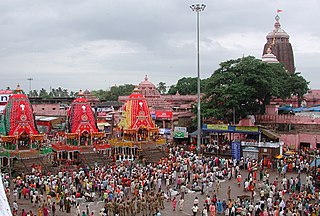
Ratha Yatra is a Hindu festival associated with Lord Jagannath held at Shri Khetra Puri Dham in the state of Odisha, India. It is the oldest Ratha Yatra, whose descriptions can be found in Brahma Purana, Padma Purana, and Skanda Purana and Kapila Samhita. Rath Yatra or Jatra is the celebration of the Lord Jagannath, who is believed to be the Lord of Universe's journey towards his aunt's house.

Zatra is the Konkani language term for the pilgrimage festivals celebrated at Hindu temples in Goa; the Hindi, Marathi and Nepali language equivalents are Yatra and Jatra respectively. In Maharashtra the alternative term Urus is used as well.
Buddhism in Nepal started spreading since the reign of Ashoka through Indian and Tibetan missionaries. The Kiratas were the first people in Nepal who embraced Gautama Buddha’s teachings, followed by the Licchavis and Newar people. Buddha was born in Lumbini in the Shakya Kingdom. Lumbini is considered to lie in present-day Rupandehi District, Lumbini zone of Nepal. Buddhism is the second-largest religion in Nepal. According to 2001 census, 10.74% of Nepal's population practiced Buddhism, consisting mainly of Tibeto-Burman-speaking ethnicities, the Newar. However, in the 2011 census, Buddhists made up just 9% of the country's population.

Jatra is a popular folk-theatre form of Odia theatre, Bengali theatre, spread throughout most of Odia, Bengali speaking areas of the Indian subcontinent, including Bangladesh and Indian states of Odisha, West Bengal, Bihar, Assam and Tripura As of 2005, there were some 55 troupes based in Calcutta's old Jatra district, Chitpur Road, and all together, jatra is a $21m-a-year industry, performed on nearly 4,000 stages in West Bengal alone, where in 2001, over 300 companies employed over 20,000 people, more than the local film industry and urban theatre.

The culture of West Bengal is an Indian culture which has its roots in the Bengali literature, music, fine arts, drama and cinema. Different geographic regions of West Bengal have subtle as well as more pronounced variations between each other, with Darjeeling Himalayan hill region and Duars showing particularly different socio-cultural aspects.
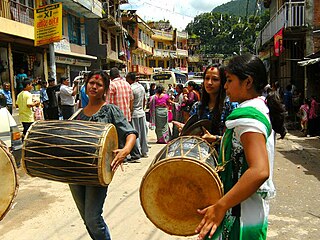
Dhimay, Dhimaya or Dhime (धिमे) is a drum, and according to the Sachs-Hornbostel classification belongs to the category of double-headed cylindrical membranophone.
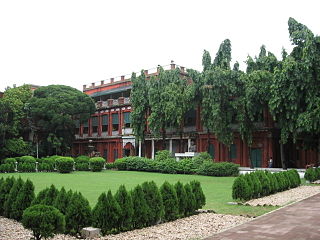
Jorasanko is a neighbourhood of North Kolkata, in Kolkata district, West Bengal, India. It is so called because of the two (jora) wooden or bamboo bridges (sanko) that spanned a small stream at this point.

Yātrā, in Indian-origin religions, Hinduism, Buddhism, Jainism and Sikhism, generally means a pilgrimage to holy places such as confluences of sacred rivers, sacred mountains, places associated with Hindu epics such as the Mahabharata and Ramayana, and other sacred pilgrimage sites. Visiting a sacred place is believed by the pilgrim to purify the self and bring one closer to the divine. The journey itself is as important as the destination, and the hardships of travel serve as an act of devotion in themselves.

Nagadesh is an ancient Newar city in Madhyapur Thimi Municipality in Bhaktapur District in the Bagmati Zone of central Nepal. In 2011 it had a population of approximately 6,900 with more than 1500 houses in it, according to the 2011 Nepal census. At the time of the 1991 Nepal census it had a population of 4,237 with 693 houses in it. Most people are engaged in farming.

The Snana Yatra/Jatra is a bathing festival of deities celebrated on the Purnima of the Hindu month of Jyeshtha. It is the auspicious birthday of Lord Jagannath. It is an important festival for the Sanatana or Hindu dharma. This is the first occasion in the year as per the Hindu calendar, when the deities Jagannath, Balabhadra, Subhadra, Sudarshana, and Madanmohana are brought out from the Jagannath Temple (Puri) and taken in a procession to the Snana Bedi. There they are ceremonially bathed and decorated for a public audience with the devotees.
Nammoora Jatre is a major Hindu festival associated with Lord Tontadraya Math held at Gadag in the state of Karnataka, India during the month of February.
Sitalasasthi is celebrated as the marriage of Shiva and Parvati, a major festival of Utkal Brahmins since ages. It was started 400 years ago in Sambalpur after the king of Sambalpur brought Utkal Srotriya Vaidika Brahmins from brahmin sasana villages of Puri district. The localities of Nandapada are the oldest of these Brahmins. They first started Sitalsasti Utsav. This Hindu festival is in the form of a carnival where people and artists from different walks of life participate making it more beautiful and bringing out the true colours of life. Every year it is celebrated towards the end of the summer season, the aim being to call the rain Gods to give reprieve from the scorching heat of the Sun. During the carnival period, Sambalpur attracts tourists from nearby states and abroad also.
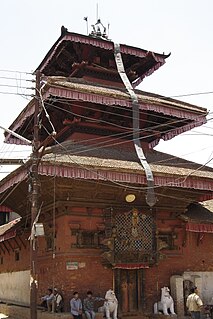
Lubhu is a place that is part of Mahalaxmi Municipality in Bagmati Province of central Nepal. Lubhu is a sub-urban Newar place situated seven kilometers east of Kathmandu in northern part of Lalitpur, Nepal.
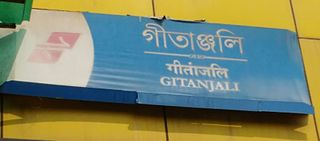
Naktala is a neighbourhood in South Kolkata in West Bengal, India. It is bounded by Ganguly Bagan to the north, Bansdroni to the west, Garia Crossing to the south and Baishnabghata Patuli to the east.

Indra Jātrā, also known as Yenyā, is the biggest religious street festival in Kathmandu, Nepal. The celebrations consist of two events, Indra Jātrā and Kumāri Jātrā. Indra Jātrā is marked by masked dances of deities and demons, displays of sacred images and tableaus in honor of the deity Indra, the king of heaven. Kumāri Jātrā is the chariot procession of the living goddess Kumari.

Nemesis is a Bangladeshi rock band formed in 1999 in Dhaka. They are one of the most popular rock bands in Bangladesh. The band rose to mainstream fame in the late 2000s and early 2010s with their hit songs like "Obocheton", "Dhushor Bhabna", "Bir" and "Kobe". They are considered to be one of the pioneers of alternative rock music in Bangladesh. Since 1999, they have released three studio albums. The current line-up includes vocalist Zohad Reza Chowdhury, guitarists Sultan Rafsan Khan and Zafir Huq, bassist Raquibun Nabi Ratul and drummer Dio Haque.

Ratha Jatra,(; lit. 'Chariot journey'), is a Hindu festival celebrated in Odisha and Southern portion Of Jharkhand for Jagannath and associated Hindu deities.
Jatra is a type of Odia theater performance in the Indian state of Odisha. The Jatra season begins from autumn and continues until the monsoon months of June. The Jatra is usually performed on an open-air stage with an audience seated on all sides. The performance includes play, music and dance.
The village of Pipili, Puri district, Odisha, India, is well known for its appliqué work, also known as Chandua. "Appliqué" comes from the French word appliquer, meaning "to put on". There are two variants to this technique: appliqué, where a fabric shape is sewn over a base layer, and reverse appliqué, wherein two layers of fabric are laid down, and a shape is subsequently cut out from the upper layer, exposing the lower layer, before both are stitched together. It is one of the products which has been granted Geographical Indication (GI) by the government of India.

Siddhikali Temple is a Hindu temple located in Thimi, Nepal. The two storeys roofed temple is dedicated to Lord Kali, Shiva and Ganesh. It is also believed that this Shaktipeeth is formed due to the falling of right eye of the corpse of Sati. This place is located in Inayekwo, in the north west of Thimi. The temple is also known as Inayekwo Dyo in Nepal Bhasa language. And Siddhikali Temple is also known as Chamunda, one of the goddess of Astamatrika. The majestically impressive Siddhikali temple has numbers of Pataa streaming down the front. There's a Satah (rest-house) opposite to temple and multiple Falcha (Inns) and several smaller shrines to the rear and nearby and several stone taps around the place. The artwork around the Siddhikali temple is fantastic and worth a close inspection.
References
- ↑ "Jwajalapa". Archived from the original on 2007-09-27. Retrieved 2007-07-15.